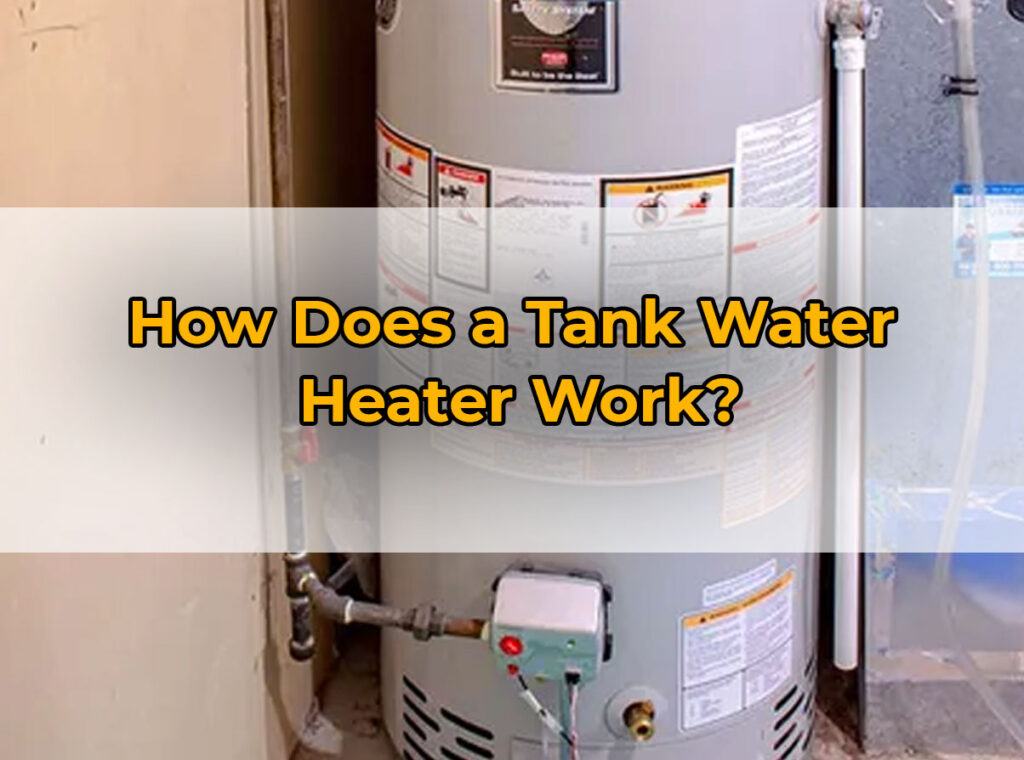Find difficulties on comparing Tankless Water Heater Vs Tank? When it comes to water heaters, there are two main types: tankless and tank. Tankless water heaters have become extremely popular due to their energy efficiency and space-saving advantages for your bathroom.
On the other hand, tank water heaters are more traditional and have been used for many years. Let’s explore the key differences between the two.
How Does a Tankless Water Heater Work?

A tankless water heater, also known as an on-demand water heater or instantaneous water heater, operates differently than traditional storage tank water heaters.
Instead of storing and continuously heating a large volume of water, tankless water heaters heat the water as it flows through the unit. Here’s a basic overview of how a tankless water heater works:
1. Water Flow
When you turn on a hot water tap in your home, cold water enters the tankless water heater through an inlet pipe.
2. Heat Exchanger
Inside the tankless water heater, there is a heat exchanger, which is typically made of copper or stainless steel. The heat exchanger is responsible for heating the water.
3. Activation
The water heater’s computer or flow sensor detects the water flow when you open the hot water tap. This triggers the heating process.
4. Burner or Heating Element
In a gas-powered tankless water heater, a gas burner is ignited to produce a flame. The heat exchanger transfers heat from the burner to the water flowing through it. In an electric tankless water heater, electrical heating elements heat the water directly.
5. Temperature Control
The tankless water heater has a control mechanism to maintain the desired hot water temperature. The flow rate and burner or heating element output are adjusted accordingly to reach and maintain the set temperature.
6. Continuous Flow
As long as you keep the hot water tap open, the tankless water heater continues to heat the water. The heating process is instantaneous, so there’s no need to wait for a storage tank to fill up or for the water to reach the desired temperature.
7. Shut-off
When you close the hot water tap, the flow sensor detects the decrease in water flow and signals the tankless water heater to shut off. This stops the heating process, conserving energy.
Tankless Water Heater Pros
To reap the benefits of a tankless water heater over a tank water heater, consider the advantages of energy efficiency, space-saving, longevity, and cost savings.
With various features that cater to your lifestyle, you can choose a tankless option that fulfills these benefits and provides consistent hot water on demand.
1. Energy Efficiency
Tankless water heaters offer many advantages when it comes to energy efficiency. They are designed to be more efficient than traditional tank heaters.
A key reason is that they don’t store hot water in large amounts, which can lead to heat loss and energy use. Instead, the tankless heater warms the water as it passes through. Also, tankless heaters use less energy, reducing fuel costs.
Since these units don’t have large tanks that continuously keep heated water, they lose less heat over time compared to standard heaters. This results in expected savings on electricity bills, while also reducing household energy consumption.
2. Space-saving
Tankless water heaters save space! They’re compact and fit in tight spaces like closets or utility rooms. Plus, they provide greater efficiency and energy savings with no standby heat loss. These units heat only when you need them, saving you energy and money.
They also offer an extended lifespan of up to 20 years with proper maintenance. That’s double the average life span of traditional storage tanks.
For added convenience, get a tankless water heater with remote control or Wi-Fi connectivity. You’ll have total control over your hot water usage – and won’t be left with a cold shower like your last relationship!
3. Longevity
Say goodbye to high water bills and hello to tankless wonders – the only thing getting hot now is your savings account! Tankless water heaters offer an extended lifespan compared to traditional systems. They heat water as it flows, instead of storing it in a tank. This reduces energy waste, sediment build-up, and corrosion, and can last up to 20 years with proper maintenance.
Though a tankless unit may cost more upfront, it saves money in the long run due to fewer replacements. Plus, they take up less space in homes. A customer shared how she lowered her monthly utility bills significantly and never ran out of hot water after upgrading to a tankless model.
4. Cost Savings
Tankless water heaters come with economic perks that make them a popular choice for homeowners. These are some of the cost-saving advantages:
- Energy Efficiency – Tankless water heaters use up to 50% less energy than traditional tanks, resulting in lower utility bills.
- Longevity – Tankless units may last for up to 20 years or more. This means fewer maintenance and replacement costs.
- Reduced Water Loss – No tank is needed, so tankless units don’t waste water when heating. This helps customers save money.
Tankless models are also environmentally friendly. They produce fewer greenhouse gas emissions than traditional water heaters since they only operate when hot water is needed.
Tankless Water Heater Cons
To grasp the drawbacks of a tankless water heater, consider the higher upfront cost, limited hot water supply, and complex installation required. These sub-sections are essential to know before choosing this type of water heater, as they can impact your decision and satisfaction with your investment.
1. Higher upfront cost
Initial Cost of Tankless Water Heaters = More Money.
Advanced technology and eco-friendliness come with a high up-front cost.
Plus, special maintenance needs can make them less practical. Installation may also require infrastructure changes and extra construction expenses.
Pro Tip: Check with your local utility provider for energy-efficient models that comply with building codes. Hot water heating performance guaranteed! No more hot potato with the showerhead!
2. Limited Hot water supply
Tankless water heaters can give trouble when it comes to meeting the demands of high usage households. That’s ’cause they heat water as it flows through the system, not keep it hot in a tank. So if multiple taps are used at once, the output drops and there’s not enough heat for all fixtures.
Plus, large families may need more than one tankless unit to get enough hot water during peak times. That can push up the price compared to a traditional tank. Big bathtubs and spas can be tricky too, needing higher flow rates and temperatures.
3. Complex installation
Tankless water heaters have intricate installation processes. This might be too tricky for homeowners wanting to upgrade. To make it easier, here’s a 6-step guide:
- Consult a pro plumber to know the size and place of the unit.
- Check if electrical and gas connections match your home’s infrastructure.
- Set up ventilation systems to avoid carbon monoxide in closed spaces.
- Install isolation and pressure relief valves for safe increasing water pressure and temperature.
- Test the system to ensure proper function before use.
- Conduct regular upkeep to prevent malfunctions or breakdowns.
Improper installation could lead to decreased efficiency and safety hazards like CO leaks. Get a qualified installer who can provide guidance and recommendations for extra equipment and maintenance. By following these steps, homeowners can now enjoy their tankless water heater stress-free!
How Does a Tank Water Heater Work?

A tank water heater, also known as a storage water heater, operates by storing and constantly heating a volume of water within a tank.
Here’s a basic overview of how a tank water heater works:
1. Water Storage
The tank water heater or water heater expansion tank consists of a large insulated tank that holds a predetermined volume of water, typically ranging from 20 to 80 gallons. The tank is made of steel or glass-lined steel to prevent corrosion.
2. Inlet and Outlet
The water heater has an inlet pipe through which cold water enters the tank from the main water supply. The hot water outlet pipe allows heated water to flow out to the various faucets and appliances in your home. Check also: Hot Water Pressure Low But Cold Fine.
3. Heating Mechanism
The tank water heater has a heating mechanism located at the bottom of the tank. In most cases, this mechanism consists of one or two electric heating elements or a gas burner (powered by natural gas or propane) positioned beneath the tank.
4. Temperature Control
The water heater is equipped with a thermostat that monitors the temperature of the water inside the tank. When the temperature drops below the desired level, the heating elements or burner are activated to heat the water.
5. Heating Cycle
When the heating elements or burner are activated, they transfer heat to the water through direct contact or through a heat transfer medium (e.g., a coil or flue). The heat raises the temperature of the water inside the tank.
6. Reheating
As hot water is drawn from the tank for use in your home, cold water enters the tank through the inlet pipe to replace it. The thermostat senses the drop in temperature and initiates another heating cycle to maintain the set temperature.
7. Standby Heat Loss
Even when hot water is not being used, heat loss occurs through the tank walls and pipes. This is known as standby heat loss. To reduce this loss, tanks are insulated with materials like foam or fiberglass. Check also Water Heater Sounds Like a Tea Kettle.
Tank Water Heater Pros
To understand the benefits of the tank water heater with the sub-sections including lower upfront cost, constant supply of hot water, and low maintenance as solutions.
By exploring these sub-sections, you’ll gain an understanding of why a tank water heater might be the best choice for your home.
1. Lower upfront cost
Tank water heaters offer an affordable initial investment. The cost of installation is lower than other types of heaters, making them ideal for households on a tight budget. They come in different sizes and shapes, so it’s easy to find one suitable for your needs.
Plus, they are energy efficient. Insulation materials are used to keep the heated water warm and reduce heat loss. This lowers utility bills and reduces environmental impact.
2. Constant supply of hot water
Tank water heaters provide an uninterrupted flow of hot water – like an endless supply of warmth! Plus, they save you money in the long run. Installation is easy and efficient, with safety mechanisms like emergency shut-off valves and temperature gauges for maximum protection.
3. Low maintenance
No regular maintenance of a tank water heater is needed. It’s designed to run without interruption, making it an ideal option for those who want an energy-saving and easy-to-use water heating device. Plus, its straightforward construction makes it incredibly durable. This minimizes the risk of breakdowns and increases its life span – saving you on repair bills.
Remember to take the right measures with your tank water heater. Experts recommend draining it every year to remove any build-up. This avoids problems and extends its life – a real two-in-one!
According to Energy.gov, a well-maintained tank water heater can last much longer than its predicted lifespan.
Tank Water Heater Cons
To understand the drawbacks of tank water heater with energy inefficiency, maintenance and replacement cost, and required space, let’s examine each sub-section in detail.
1. Energy Inefficiency
Traditional tank water heaters are not energy-efficient. They keep heating water all day, even when not in use, wasting energy and costing you money. Moreover, most tanks have poor insulation, leading to more heat loss.
So, what can be done? Upgrade to a tankless water heater, or add insulation to the existing tank. Tankless systems only heat water when needed, saving energy.
Another option is to get a high-efficiency tank model with better insulation and temperature regulation. Plus, regular maintenance and flushing out sediment can help keep the system running optically.
In conclusion, traditional tank water heaters are costly and inefficient. Upgrading to a better model or taking steps to improve an existing system’s performance can lower bills and reduce environmental impact.
2. Maintenance and Replacement Cost
Tank water heaters come with upkeep and replacement costs that can quickly add up. Let’s see the factors that impact these costs.
Wear and tear can affect tank water heaters. Sediment buildup or leaks may need regular maintenance or repairs. Replacement is necessary when the tank reaches its lifespan. Check tips on fixing hot water heater leaking.
Here’s a table giving a rough estimate of regular maintenance and replacement expenses for tank water heaters:
| Type of Tank Water Heater | Maintenance Cost | Replacement Cost |
|---|---|---|
| Gas | $100-$150 | $800-$1500 |
| Electric | $50-$100 | $400-$1200 |
These costs vary depending on location, installation fees, and models.
Apart from the usual maintenance and replacement costs, you may have extra expenses. For example, if you need to relocate your water heater or upgrade its capacity, you’ll pay extra charges.
3. Required Space
Installing tank water heaters requires lots of space due to their bulky size. The bigger the tank, the more space it needs. Ventilation is also essential.
This extra storage can be a bother when organizing your house. Tank water heaters take up a huge area in garages or basements, making them unsuitable for apartments and smaller homes.
Electric and gas water heating are other options. They occupy less space than tanks, and still supply hot water on demand.
Tank water heaters have been popular since Benjamin Maughan Cole first introduced them for residential use in America in the 19th century.
Tankless Water Heater VS Tank (Choosing Tips)

To compare tankless water heaters and tank water heaters effectively with respect to cost, energy efficiency, hot water supply, and longevity, explore the following sub-sections.
1. Cost Comparison
Comparing tankless and traditional tank heaters’ expenses is essential. Let’s explore their cost difference using data.
A table below shows the comparison:
| Factors | Tank Water Heater | Tankless Water Heater |
|---|---|---|
| Initial purchase and install | Cheaper but needs more space | Expensive but requires less |
| Usage Cost | More expensive due to reheating | Less expensive due to on-demand heating |
| Maintenance cost | Varies depending on build quality & age | Low maintenance cost |
Note: Prices vary based on models, power sources, sizes etc.
Cost variation between tank and tankless water heaters is unique. It is pricey at first, but energy-efficient tech & no redundancy make it a budget-friendly option in the long run.
Pro Tip: Audit your hot water needs to find out if switching to a tankless model would lower energy expenses.
Tankless water heaters are like an economical granny; tank water heaters are like a reckless teen with their parent’s credit card.
2. Energy Efficiency Comparison
Tankless Water Heaters vs. Tank Water Heaters: time to compare energy efficiency! Compare their Energy Factor (EF), Flow Rate (GPM), Cost, Lifespan and Installation requirements using a table. Studies say tankless heaters use “on-demand” heating, saving up to 34% more energy than storage systems. Plus, they last longer and require less maintenance. They also take up less wall space, making them perfect for small places.
Although tankless heaters are becoming popular, only 2% of Americans have installed them in the last decade. Japan, however, has almost all tankless water heaters. Knowing the differences helps us choose the best water heater system for our home. It’s time to upgrade – save energy, money and time!
The following table compares Tankless Water Heaters vs. Tank Water Heaters:
| Tank Water Heaters | Tankless Water Heaters | |
|---|---|---|
| Energy Factor (EF) | 0.67 – 0.70 | 0.82 – 0.98 |
| Flow Rate (GPM) | 5 – 8 | 2 – 5 |
| Cost | Less expensive up front | More expensive up front |
| Lifespan | 10 – 15 years | 20 years or more |
| Installation requirements | Large space, ventilation and gas line, drain, and electricity supply | Small space, wall-mounted, only need gas line and ventilation |
3. Hot Water Supply Comparison
When thinking about hot water delivery, there are both positives and negatives to tankless water heaters and traditional tank water heaters.
Also, it’s important to note that with tankless water heaters, you may get endless hot water. However, traditional tank water heaters have limitations when it comes to using hot water for multiple purposes.
For example, a house with multiple showers/drains needs around 100 gallons of hot water an hour – which can cost $15-$20 per day if the tank is higher than 50 gallons.
4. Longevity Comparison
Comparing tankless water heaters and tank water heaters? Let’s take a look at the lifespan stats. Tankless water heaters have an average lifespan of 20-30 years, while tank water heaters come in at 10-15 years.
This can be attributed to the fact that tankless models don’t store large volumes of water, preventing rust and sediment build-up. Plus, they require less maintenance and offer superior performance with reduced energy costs.
Bear in mind that aside from lifespan, there are other differences to consider like upfront cost, installation requirements, and capacity.
So when it comes to purchasing a new system or replacing an old one, carefully weigh up all options to suit your household’s needs. Invest in the best for long-term benefits. Hot water is still hot water!
Final Verdict on Tankless Water Heater vs Tank Water Heater
Tank Water Heaters:
- Initial Cost: Less expensive
- Operating Cost: Higher
- Hot Water Supply: Limited
- Space Requirement: Takes up more space
Tankless Water Heaters:
- Initial Cost: More expensive
- Operating Cost: Lower
- Hot Water Supply: Unlimited
- Space Requirement: Requires less space
Other factors to consider are installation difficulty, maintenance, lifespan and climate.
Can you run out of hot water with a tankless water heater?
The answer is no, technically speaking. A properly sized and installed tankless water heater will never run out of hot water as long as it’s properly maintained.
Unlike traditional storage tanks that can become depleted when the hot water runs out, a tankless unit heats up the cold incoming water as it passes through its heat exchanger. This means that there’s no need to wait for the storage tank to refill and reheat, which results in an endless supply of hot water.
Can I take a long shower with a tankless water heater?
The simple answer is yes, you can take a long shower with a tankless water heater, but there are some important factors to consider.
Firstly, the size of your tankless water heater matters. If you have a small unit that cannot meet your household’s hot water demands, taking long showers may result in lukewarm or cold water.
Therefore, it is crucial to choose an appropriately sized unit based on your family’s hot water usage patterns. Secondly, if multiple people want to take long showers simultaneously, this may also affect the performance of your tankless system since it has to supply hot water to more than one outlet at once.
Can you run 2 showers with a tankless water heater?
The answer is yes, but it depends on a few factors.
Firstly, you will need to ensure that your tankless water heater has a high enough flow rate to accommodate two showers simultaneously. This means looking at the unit’s specifications and checking its gallons per minute (GPM) rating.
A typical tankless water heater can provide between 2-5 GPM, so if your showers use less than this amount each, then you should be able to run them both without issue.
Secondly, you will need to consider the temperature rise needed for each shower.
“There is no real ending. It’s just the place where you stop the story.”






